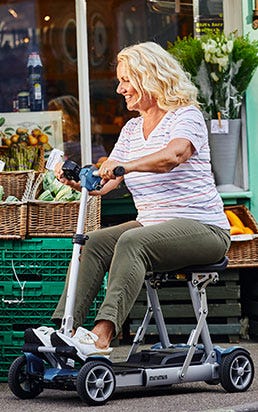If you have a summer holiday planned and want to take your travel mobility scooter along with you you’ll want to check that the scooter batteries it contains are compliant with the rules about luggage. To help you determine whether or not your mobility scooter batteries are suitable here’s a quick guide to let you know what to check for.
Check the Type of Your Mobility Scooter Batteries
The likelihood is that your scooter is powered by one of three types of battery; lead acid (SLA), nickel metal hydride (NiMH), or lithium ion (Li Ion). All types of mobility scooter batteries are what’s known as non-spillable batteries and are safe to take on a plane. Sounds pretty straightforward, right? In the case of SLA and NiMH batteries this is certainly true, but lithium ion batteries have additional rules that must be followed for safety purposes. Different airlines have different rules about the exact restrictions of Li Ion batteries. However, a good rule of thumb to keep in mind is that a single Li Ion battery must not exceed 300Wh and two batteries must not exceed 160Wh each. If the watt hours (Wh) are not displayed on your battery, simply multiply amp hours (ah) by voltage to get the amount. If you have a specialised travel scooter it’s unlikely that it will exceed the limit. Nevertheless, it’s crucial to thoroughly check both the replacement mobility scooter batteries and the specific airline rules before travel.
Packaging Your Batteries and Planning Ahead
In addition to the watt hour restriction you should ensure that your Li Ion batteries are prepared correctly for travel. Firstly, you should disconnect the battery from the scooter and package it separately. The International Air Transport Association (IATA) states that you should not use the external packaging as the sole means of protection. Using bubble wrap or an equivalent protective layer will keep it safe from damage and keep you within the rules. SLA and NiMH batteries are permitted to stay connected to the scooter, or you can dissemble it completely. It’s also important to plan ahead before turning up to the airport. Before the day of your flight inform the airline that you’re flying with that you intend to take a mobility scooter with you. You will likely be asked the battery type, it’s specifications, and possibly the make and model of your scooter, so have this information ready before hand. Additionally, there will likely be forms you need to fill out before travelling and medical information – such as a doctor’s note – may also be required as proof of your reliance on the scooter. Following these guidelines should keep you in the clear when taking your mobility scooter batteries abroad. If you have any doubts about whether or not your scooter is in the clear, check the manual for battery information and call your airlines customer services to get clarification.


 Price Match Promise
Price Match Promise
 Next day delivery, 7 days a week
Next day delivery, 7 days a week
 Nationwide Showrooms
Nationwide Showrooms
 Rated Excellent
Rated Excellent







